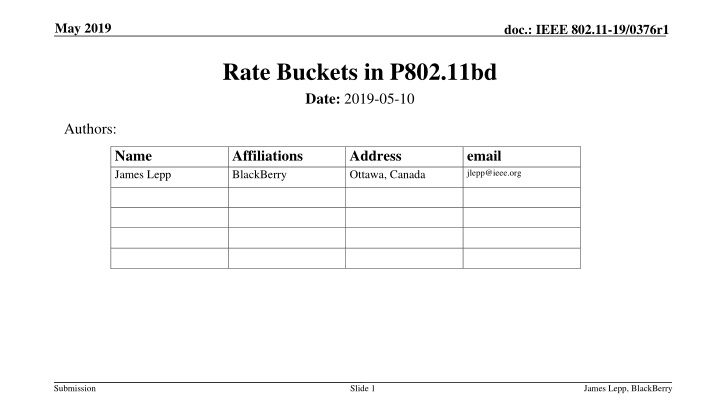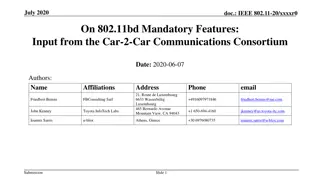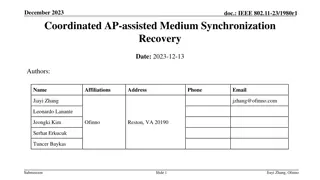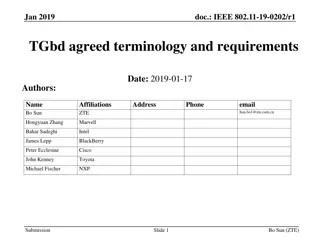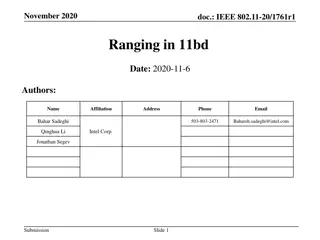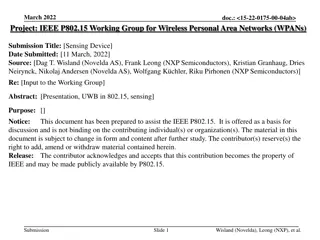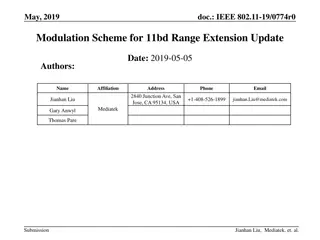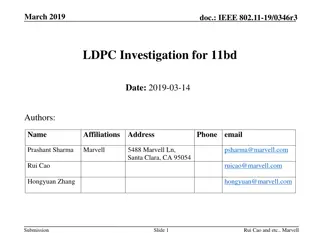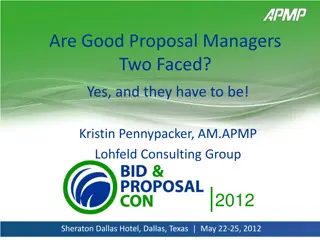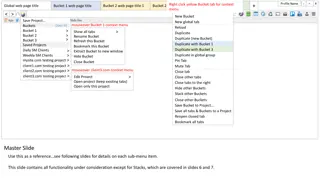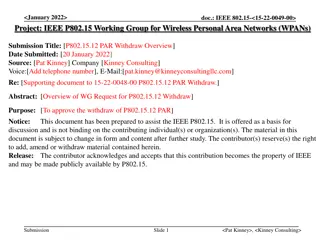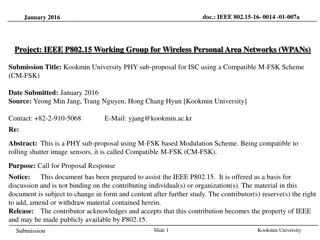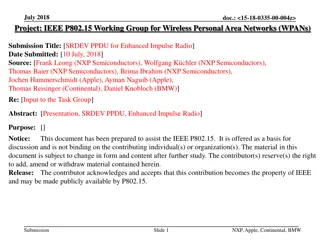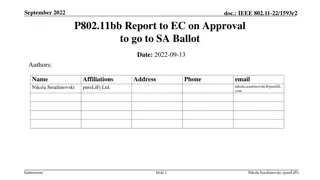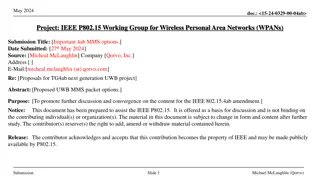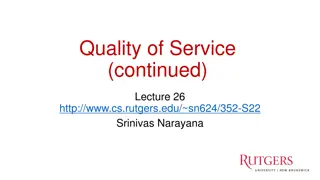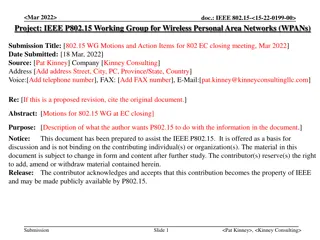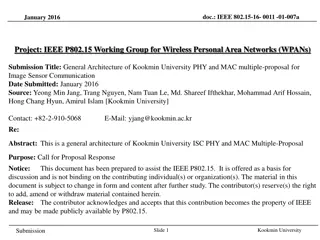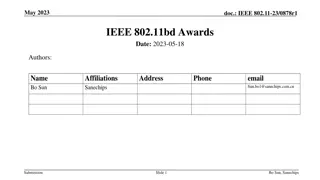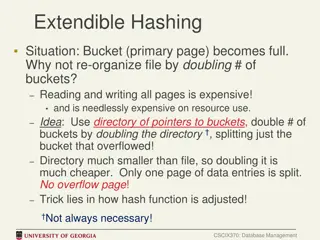Rate Buckets in P802.11bd Proposal
This document, authored by James Lepp from BlackBerry, discusses Rate Buckets in the P802.11bd proposal published in May 2019 under IEEE 802.11-19/0376r1. The focus is on the Rate Buckets concept within the IEEE 802.11bd standard, relevant to wireless communications, particularly for high-speed vehicular environments.
Download Presentation

Please find below an Image/Link to download the presentation.
The content on the website is provided AS IS for your information and personal use only. It may not be sold, licensed, or shared on other websites without obtaining consent from the author.If you encounter any issues during the download, it is possible that the publisher has removed the file from their server.
You are allowed to download the files provided on this website for personal or commercial use, subject to the condition that they are used lawfully. All files are the property of their respective owners.
The content on the website is provided AS IS for your information and personal use only. It may not be sold, licensed, or shared on other websites without obtaining consent from the author.
E N D
Presentation Transcript
May 2019 doc.: IEEE 802.11-19/0376r1 Rate Buckets in P802.11bd Date: 2019-05-10 Authors: Name James Lepp Affiliations BlackBerry Address Ottawa, Canada email jlepp@ieee.org Submission Slide 1 James Lepp, BlackBerry
March 2019 doc.: IEEE 802.11-19/0376r1 Abstract 802.11bd will continue to allow the legacy 802.11p rates for backwards compatibility 802.11bd PAR has two differing goals that may lead to two different new PPDU formats Longer Range Highly Robust Submission Slide 2 James Lepp, BlackBerry
May 2019 doc.: IEEE 802.11-19/0376r1 PAR [1] 5.2.b. Scope of the project: This amendment defines modifications to both the IEEE 802.11 Medium Access Control layer (MAC) and Physical Layers (PHY) for vehicle to everything (V2X) communications for 5.9 GHz band as defined in clauses E.2.3 and E.2.4 of IEEE Std 802.11(TM)-2016; and, optionally, in the 60 GHz frequency band (57 GHz to 71 GHz) as defined in clause E.1 of IEEE Std 802.11(TM)-2016. This amendment defines at least one mode that achieves at least 2 times higher throughput (measured at the MAC data service access point) than as in IEEE Std 802.11(TM)-2016 operating at maximum mandatory data rate as defined in the 5.9 GHz band (12 Mb/s in a 10 MHz channel), in high mobility channel environments at vehicle speeds up to 250 km/h (closing speeds up to 500 km/h); this amendment also defines at least one mode that achieves at least 3dB lower sensitivity level (longer range), than that of the lowest data rate defined in IEEE Std 802.11(TM)-2016 operating in 5.9 GHz band (3 Mb/s in a 10 MHz channel); and this amendment defines procedures for at least one form of positioning in conjunction with V2X communications. This amendment shall provide interoperability, coexistence, backward compatibility, and fairness with deployed OCB (Outside the Context of a BSS) devices. Submission Slide 3 James Lepp, BlackBerry
May 2019 doc.: IEEE 802.11-19/0376r1 Discussion At least 3 modes at least 3 PPDU types Legacy PPDU (802.11p) High throughput PPDU (802.11bd mode A) Long range PPDU (802.11bd mode B) Submission Slide 4 James Lepp, BlackBerry
May 2019 doc.: IEEE 802.11-19/0376r1 Target Ratesets Legacy 802.11p[2] PPDU (any new text needed?) 3 4.5 6 9 12 18 24 27 802.11bd High Throughput PPDU (Actual rates are TBD) 6 ? ? ? ? ? 54? 100? 802.11bd Long Range PPDU (Target the same rates?) 3 4.5 6 9 12 18 24 27 *All still assuming 10MHz channels in 5.9GHz band Submission Slide 5 James Lepp, BlackBerry
May 2019 doc.: IEEE 802.11-19/0376r1 Open issues 1) Any chance we can retroactively rename the legacy rate set (802.11a 10MHz aka 802.11p)? Note 802 EC objections to referencing obsolete amendments . However the industry still calls it 802.11n, 802.11ac, etc. Need to treat this issue carefully either way. 2) How do we enable the upper layer application to choose the rateset and rate that it needs? (legacy, high throughput, or long range) For example choosing 6Mbps legacy PPDU for transmitting BSM, 6Mbps long range PPDU for sending Platooning Discovery messages and high throughput 100Mbps PPDU for sensor sharing. Submission Slide 6 James Lepp, BlackBerry
May 2019 doc.: IEEE 802.11-19/0376r1 Straw poll 1 Should 802.11bd consider multiple PPDU formats? 1. Yes 2. No 3. Abstain Submission Slide 7 James Lepp, BlackBerry
May 2019 doc.: IEEE 802.11-19/0376r1 Straw poll 2 What kind of rates should the 802.11bd long range PPDU target? 1. Same rates as 802.11p 2. Mostly the same plus some lower rates 3. Mostly the same plus some higher rates 4. Abstain 3 4.5 6 9 12 18 24 27 Submission Slide 8 James Lepp, BlackBerry
May 2019 doc.: IEEE 802.11-19/0376r1 Straw poll 3 Should the 802.11bd MAC provide multiple rate buckets to the upper layer based on the features such as legacy compatibility , high throughput and long range ? 1. Yes 2. No 3. Abstain Submission Slide 9 James Lepp, BlackBerry
May 2019 doc.: IEEE 802.11-19/0376r1 References 1) IEEE P802.11bd PAR https://development.standards.ieee.org/P1080000033/par 2) IEEE 802.11-2016 - Table 17-4 Submission Slide 10 James Lepp, BlackBerry
